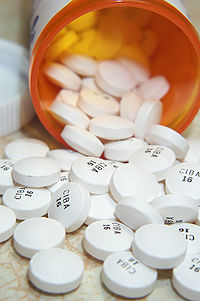
Photo from wikipedia
Purpose of study Illicit use and diversion of medications used to treat attention-deficit/hyperactivity disorder (ADHD) has been a public concern. The objective of this study is to identify the prevalence… Click to show full abstract
Purpose of study Illicit use and diversion of medications used to treat attention-deficit/hyperactivity disorder (ADHD) has been a public concern. The objective of this study is to identify the prevalence and characteristics of stimulant misuse among college students. Methods used A comprehensive search was done using Pubmed, Google Scholar and review of reference lists. Studies published after year 2000 and performed at a U.S. college were included in the final analysis. We also included case reports that documented major side effects since they were not addressed in the larger studies. Summary of results Eleven large studies that analysed misuse and 5 case reports were found. Majority of the studies were survey based and the sample size ranged from 98 to 21 771. Lifetime use among college students ranged from 5.5% to 35.5%. Past-year misuse of stimulants ranged from 4.1% to 10.6%, and appeared to have increased in recent years while nonmedical use of certain drugs, such as opioids decreased. In addition, recently, majority of college students reported using an amphetamine-dextroamphetamine combination agent (Adderall) compared to a methylphenidate product (e.g., Ritalin, Concerta, Metadate, Methylin). Misuse was more prevalent among students attending certain colleges and further among subgroups of college students; majority of misuse was among Caucasian males. Reasons given for misuse included improving concentration and academic performance, getting ‘high’, keeping awake, peer pressure, and losing weight (especially among females). Misusers were more likely to report illicit use of other drugs or alcohol, and the most common way of obtaining the medication was from a friend. Some side effects reported in large survey-based studies included: mood changes, addiction, loss of appetite and insomnia. Case reports of major side effects associated with misuse included: cardiac infarction, cardiomyopathy, psychosis and sudden death. Conclusions Stimulant misuse continues to be prevalent among college students. It is imperative that healthcare professionals inquire and educate youth about stimulant misuse, and college counsellors increase youth awareness about the legal implications of diversion and potential side effects of misuse.
Journal Title: Journal of Investigative Medicine
Year Published: 2018
Link to full text (if available)
Share on Social Media: Sign Up to like & get
recommendations!